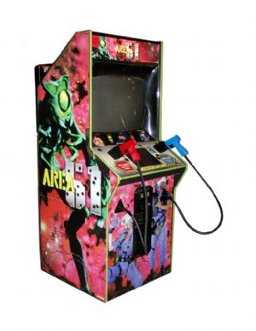Area 51 (1995 video game)
| Area 51 | |
|---|---|
 The arcade unit of Area 51 | |
| Developer(s) | Mesa Logic |
| Publisher(s) | Atari Games/TimeWarner Interactive Soft Bank (Japan) |
| Designer(s) | Robert Weatherby |
| Series | Area 51 |
| Platform(s) | Arcade PlayStation Saturn PC |
| Release date(s) | Arcade
PlayStation |
| Genre(s) | First-person shooter |
| Mode(s) | Up to 2 players simultaneously |
| Cabinet | Standard |
| Arcade system | CoJag |
| Display | Raster, 320 x 240 pixels (Horizontal), 65534 colors |
Area 51 is a light gun arcade game released by Atari Games in 1995.[1] It takes its name from the Area 51 military facility.
The plot of the game involves the player (Peterson) taking part in a STAAR (Strategic Tactical Advanced Alien Response) military incursion to prevent aliens, known as the Kronn, and alien-created zombies from taking over the Area 51 military facility.
The game was ported to the PlayStation, Sega Saturn and personal computers.
Gameplay
.png)
This game takes the player through several sections of the facility, including a warehouse and underground tunnels. The player character is tasked, along with fellow Special Tactical Advanced Alien Response (STAAR) members Lieutenant Stephanie Grant and Sergeant Major Marcus Bradley, to penetrate Area 51 and activate the nuclear self-destruct sequence. The player must kill any attacking genetically altered soldiers and aliens without harming any allied STAAR team members. If nothing but three STAAR team members are shot, the Kronn Hunter mode is started, taking the role of a Hunter, sent by the Kronn to eliminate the rebels.
There are five types of weaponry available. While the player is only given a semi-automatic pistol in the beginning, weapon upgrades are available as targets. The pistol can be upgraded to an automatic machine gun, a pump shotgun, and finally an automatic shotgun. The shotgun weaponry allows a greater field of error for targeting an enemy. Both the machine gun and automatic shotgun allow the player to keep the trigger pressed down to unleash rounds. If the player character is hit by the enemy at any time, the weapon is downgraded back to the pistol. Grenades are hidden in crates and bonus rooms. When used, they destroy most on screen enemies at once. The player can hold a maximum of nine grenades. In addition, yellow boxes and barrels marked with "flammable" warning symbols can be shot to cause fires or explosions that can harm enemies. By shooting certain objects in the correct sequence, players can unlock shooting exercises, weapon stashes, and bonus items that are not available in the main game plot. Other backdoors allow players to warp ahead to later levels instead of following the game's otherwise linear path.
There are many types of aliens/alien zombies including ones that shoot, punch, fire rockets, and throw things like bricks, grenades, and barrels. Purple alien/alien zombies require more hits than other targets.
Development
The game uses digitized video stored on an on-board hard disk, and gibs into which every enemy blows apart when shot, in exactly the same way. While enemies, innocents, and explosions are 2D digitized video sprites, the levels and vehicles are pre-rendered in 3D.
The game's arcade board, CoJag, is a modified Atari Jaguar with enhanced graphics and sound capabilities.
Sequel and related games
In 1998, Atari Games released an arcade sequel titled Area 51: Site 4 and re-released the first game as part of one machine called Area 51 vs. Maximum Force duo that also included Maximum Force.[2] In 2005, a first-person shooter was released that shares the name and uses the original as an inspiration was released for the PlayStation 2, Xbox, and PC. It featured a more sophisticated storyline and the voices of David Duchovny, Marilyn Manson, and Powers Boothe. The original arcade game makes a brief appearance here as well. In 2007, Midway released "BlackSite: Area 51" to multiple platforms.
Ports
In 1996, the game was ported to the PlayStation, Saturn, and PC. It was re-released on the PlayStation in 2001 by Midway as part of their Midway Classics range. Tiger Electronics later developed a miniature, handheld version of the game with an LCD screen and small light gun.
The PlayStation version supports fullscreen play, while the Saturn version has a border covering about 15% of the screen. The Saturn version supports all of the console's light guns. The PlayStation version supports the Konami Justifier, but not the Namco GunCon.
Despite the arcade version being run on a modified Atari Jaguar, it was never ported on to the system itself.
References
- ↑ Matt Cabral, "Area 51: A History of Violence," PlayStation: The Official Magazine 004 (March 2008): 82-83.
- ↑ Area 51/Maximum Force Duo Videogame by Atari Games (1998) - The International Arcade Museum and the KLOV